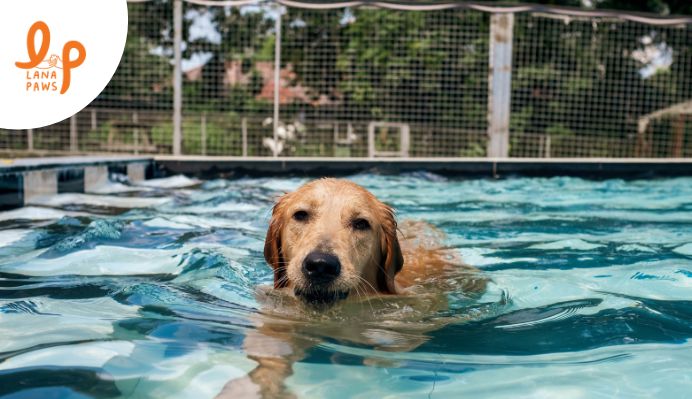
Hydrotherapy for dogs is the use of water to help dogs recover from injuries, manage chronic conditions, and maintain overall health and fitness.
Hydrotherapy can be performed in a pool, spa, or underwater treadmill and can provide a low-impact, full-body workout that can help dogs improve strength, flexibility, and mobility.
Types of hydrotherapy for dogs
There are several types of hydrotherapy for dogs, including:
- Pool therapy: This type of hydrotherapy involves dogs swimming in a pool, which can help to improve cardiovascular fitness, strengthen muscles, and increase flexibility.
- Underwater treadmill therapy: This type of hydrotherapy involves dogs walking or running on a treadmill that is submerged in water. This can help to improve endurance and muscle strength, especially in dogs recovering from injuries.
- Spa therapy: This type of hydrotherapy involves dogs soaking in a spa, which can help to relax muscles, relieve pain, and improve circulation.
When to consider hydrotherapy for your dog

Hydrotherapy is typically recommended for dogs with certain medical conditions or injuries that may benefit from the unique properties of water. Here are a few examples of dogs that may benefit from hydrotherapy:
- Dogs recovering from surgery or injury: Hydrotherapy can help to reduce pain and inflammation, increase range of motion, and promote muscle strength and endurance.
- Dogs with arthritis or hip dysplasia: Hydrotherapy can help to reduce weight-bearing stress on joints, increase flexibility, and improve overall mobility.
- Overweight or obese dogs: Hydrotherapy can help to increase cardiovascular fitness and promote weight loss, while also reducing the stress on joints.
- Dogs with neurological conditions: Hydrotherapy can help to improve balance, coordination and muscle tone.
- Dogs with chronic conditions that affect mobility: Hydrotherapy can help to improve muscle strength, endurance, and overall mobility.
- Dogs with behavioral issues: Hydrotherapy can help to reduce stress and anxiety, and improve the overall well-being of the dog.
It's also good to keep in mind that hydrotherapy is not suitable for all dogs, especially those with certain medical conditions such as heart disease, or those that have a fear of water or have certain medical conditions that could be exacerbated by water.
Maximizing mobility: The benefits of hydrotherapy for dogs

Some key benefits of hydrotherapy for dogs include:
- Increased range of motion and muscle strength
- Reduced pain and inflammation
- Improved cardiovascular fitness
- Increased endurance and stamina
- Reduced weight-bearing stress on joints
- Improved balance and coordination
- Reduced muscle spasms
- Increased circulation
- Increased flexibility
It is particularly useful for dogs recovering from surgery or injury, dogs with arthritis or hip dysplasia, and dogs that are overweight or obese.
Hydrotherapy for dogs is typically recommended by veterinarians and is often used in conjunction with other forms of rehabilitation, such as physical therapy and massage. It can be beneficial for dogs recovering from surgery, dogs with arthritis, and dogs with other conditions that affect their mobility.
Does my dog need to know how to swim?
Dogs do not need to know how to swim to participate in hydrotherapy. Hydrotherapy sessions can be tailored to the individual dog's abilities and comfort level in the water.
For dogs who are not comfortable or familiar with swimming, hydrotherapy can be done in shallow water where the dog's feet can touch the bottom, or with the use of a buoyancy device such as a flotation vest. This allows the dog to gradually become accustomed to being in the water, and to build their confidence and strength.
For dogs who are already comfortable in the water, hydrotherapy can be done in deeper water, where the dog must use their legs and core muscles to stay afloat. This can help to increase cardiovascular fitness, muscle strength, and endurance.
In any case, it's always important to have an experienced professional supervising the session to ensure the safety and well-being of the dog throughout the process.
Are there any harmful or side-effects of canine hydrotherapy?
Hydrotherapy is generally considered to be a safe and effective form of rehabilitation and exercise for dogs. However, as with any form of exercise or therapy, there are some potential side effects that should be taken into consideration.
- Dehydration: Dogs can become dehydrated if they are in the water for too long, so it's important to make sure that they have plenty of fresh water available before, during, and after the session.
- Ear infections: Dogs with floppy ears are more prone to ear infections, so it's important to dry their ears thoroughly after each session.
- Chilled dogs: If a dog is cold after a hydrotherapy session, it could lead to muscle cramping, stiffness, and even injury.
- Overuse injury: If a dog is pushed too hard during a hydrotherapy session or if they are not ready for the level of exercise, they could sustain an overuse injury.
It's important to note that hydrotherapy should only be done under the supervision of a veterinarian or a certified professional. They will be able to assess your dog's condition, and determine the most appropriate type and intensity of exercise for them.
Additionally, it is important to keep an eye on your dog during the session to see if they seem uncomfortable or stressed, and to stop the session if necessary.







